Notes from a Tillandsia discussion.
DI1113 Some Latin family names
Compiled by Ian Hook, November 2013
A short collection of Bromeliad names sourced from people we might know.
There are many such fascinating stories, but where will they ever be collated ?
Or will the origins be lost forever, simply because there is nowhere to file these tales?
If anyone has more such folk-lore, please send them to me for inclusion below.
Ian Hook, editor BinA
Peter Tristram 14/02/13 5:17pm
Not only does T. tillii pup without seed it also does with – good news in all respects. It has about 20 pods but probably all hybrids – mainly x Vriesea. The first pup from the other one I posted a couple of years ago has bloomed and hopefully it will also pup. I might get game to whack 1 outside like Lydia’s plant pictured on the dvd – full German sun!
I just hope most of the other Mexican treasures, from Lydia in particular, also pup as much of the seed harvested so far hasn’t germinated (as some of you will have also discovered). I think I got maybe 5 seedlings from each the batches I took to Albury, irrespective of the sowing method. I just sowed some T. hintoniana but I only had a few pods. It pups too.
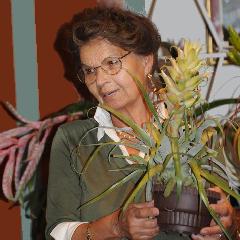
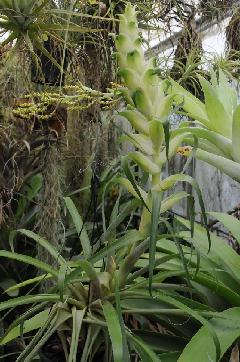
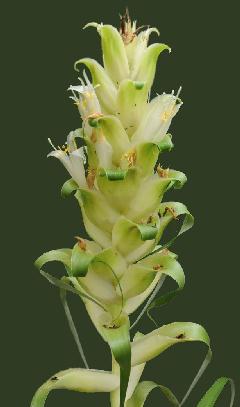
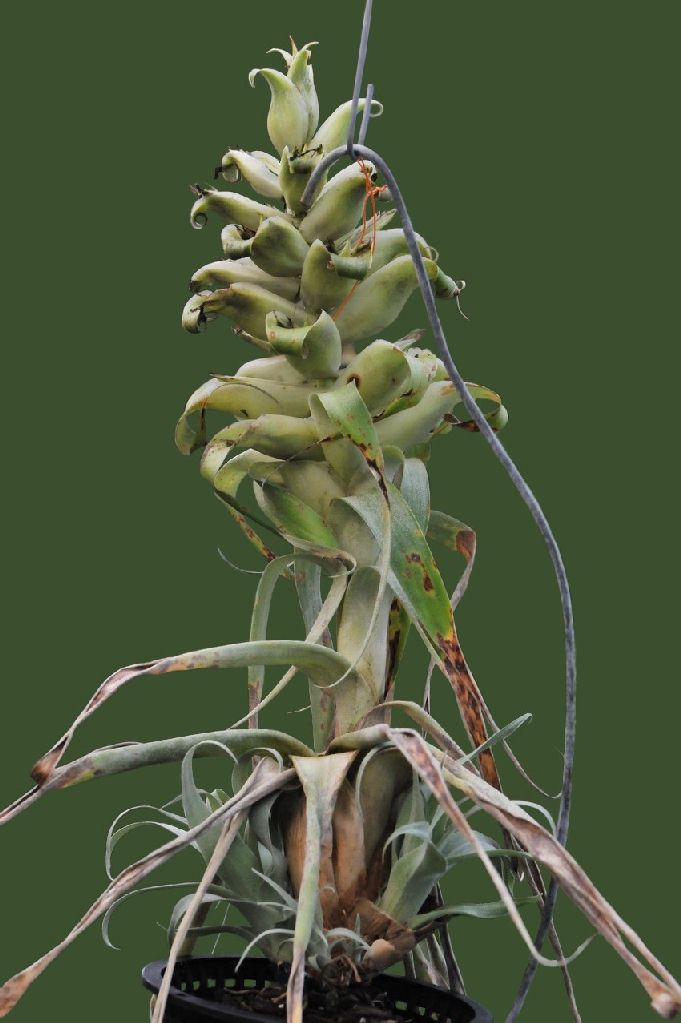
| T. tillii Lydia Köhres. |
T. tillii Peter Tristram 03/10. |
T. tillii Peter Tristram 02/13. |
I obtained this species many years ago from Alfedo Lau as a species related to T. laui, then undescribed, but it died after blooming like the lauis. No doubt Pam of Birdrock sold it as well. I also saw it in bloom at Lydia Köhres’s place growing in near full sun too. I hope it pups and/or sets seed!"
Len Colgan 14/02/13 6:16pm
Of remote interest concerning this plant, T. tillii.
Many years ago, Renate Ehlers confided that, for personal reasons, her two favourite tillandsias are, of course, T. ehlersiana and T. klausii. Because she does not have university qualifications, virtually all of her 100+ new tillandsia species descriptions contain a Latin diagnosis supplied by Walter Till. In appreciation, in the early 1990s, she wanted to name her third most favourite tillandsia in his honour as T. tillii. However, Walter declined as he preferred another plant that was also being described by Renate, which is the plant shown by Pete(above). A few years later, the "rejected" plant was named by Renate as T. salmonea due to its salmon-coloured bracts. (See below.)
Renate has always thought that Walter made the wrong decision. What do you think?
Peter Tristram 14/02/13 6:48pm
Funny how things go! Interesting stories, Len! Here’s another shot of a salmonea from Lydia taken 5 years ago. All pups I have parted with came from this plant. It’s a very slow growing, stocky plant with hard, brittle reddish leaves, very different to the softer, silvery leaves of tillii. I would be happy with either named after me!
Incidentally, I have T. klausii and T. ehlersiana in bloom now. Maybe I should cross them...
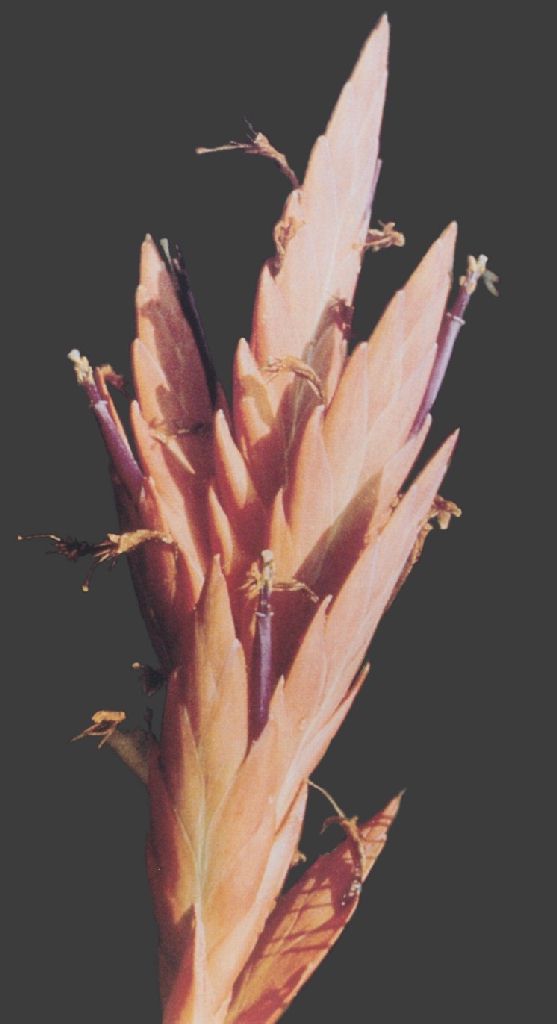
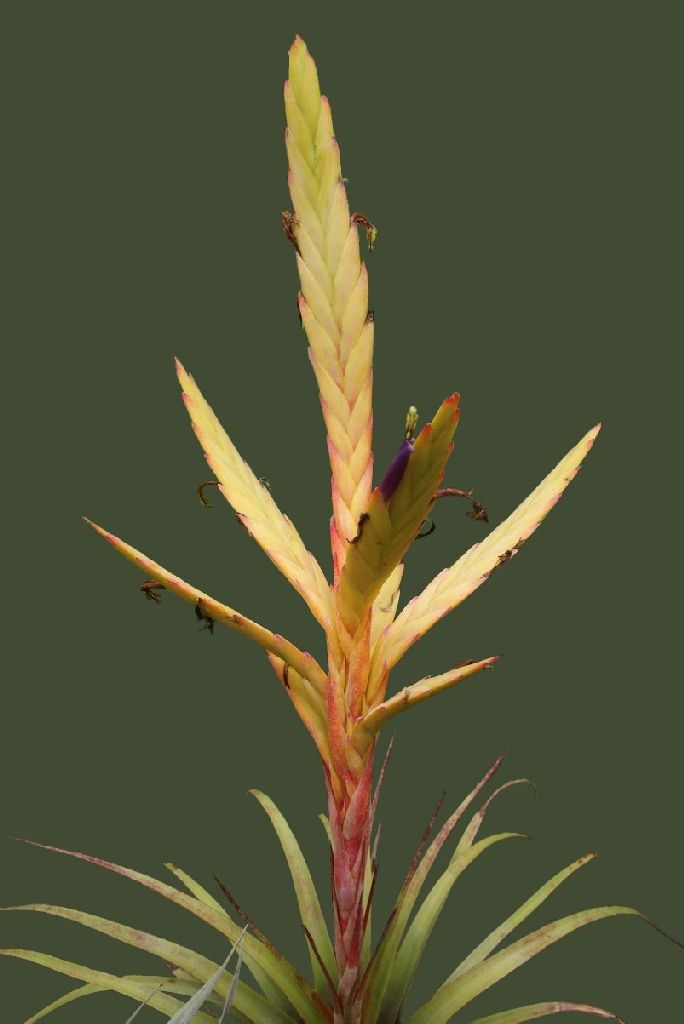
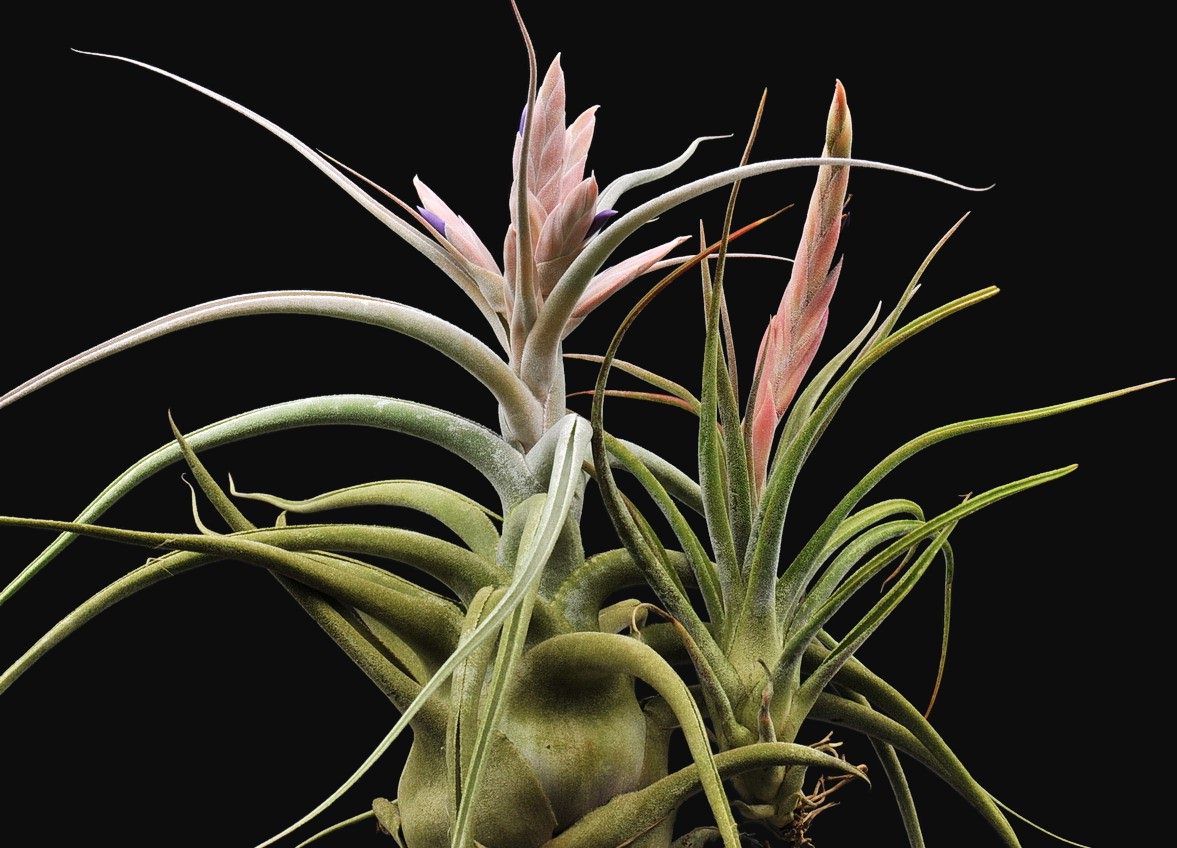
| T. salmonea Len Colgan 02/13. |
T. salmonea Peter Tristram 02/13. |
Peter Tristram 02/13. ehlersiana & klausii(30cm) large forms. |
Len Colgan 14/02/13 7:41
Interesting idea, Pete.
It is possible that some listeners to this discussion are not fully aware of T. ehlersiana and T. klausii, and why Renate is so emotionally attached to them both.
T. ehlersiana was named and described by Professor Rauh in 1984 in honour of Klaus and Renate Ehlers, almost an unknown couple to the bromeliad world at that time. The ending "iana" usually signifies a husband and wife pair. During one of their many expeditions to Mexico together, they discovered this plant.
In 1988, Renate named T. klausii in honour of Klaus. She chose that particular plant because Klaus had to shuffle up a steep rise covered in all sorts of vicious prickly plants to collect some from the open ground at the top. When he returned down, he was bleeding with numerous prickles in him. They then had to race off to apply medication, and Klaus spent considerable time recuperating in a swimming pool. Renate just had to name the species after her beloved husband, who subsequently died several years ago. In fact, I was holding his hand in a Stuttgart hospital on the night before returning to Australia. He died while I was in the air.
What is the most reprehensible omission in this whole story? There still is not a T. renatae. Of course, I am unashamedly biased, because she named and decribed T. colganii*(see below), and together we named and decribed T. rubia.
| Ed. Pictures of T. colganii and T. rubia, and their story, lower on this page. |
Len Colgan 15/02/13 7:54am
Some members might be vaguely interested in other tillandsia species involving husband and wife combinations. Most of these (since the Fosters) involve German or Austrian couples.
As well as Klaus and Renate Ehlers (discussed above), we have Helmut and Lotte Hromadnik, as well as Gerhard and Lydia Koehres.
I will not include Gerda and Erich Haugg (T. gerdae, T. erici) as there is no "T. hauggiana".
Back in the 1970s when Helmut Hromadnik was healthier, he took his wife Lotte on various tillandsia collecting expeditions, mainly in Bolivia and Peru. He named and described T. lotteae way back in 1978. Although it has been collected to extinction at the type location over the years, Lotte and I know numerous other locations where this species is flourishing, with quite different forms existing. Most of those locations are under wraps. They expanded their horizons, discovering several new species, and took various trips to Mexico also. By 1990, Lotte herself had become a real expert, and she reciprocated by describing T. helmutii (also from Bolivia) in her husband's honour. About the same time Renate Ehlers named and described the species T. hromadnikiana after the pair, a plant they found in Mexico. As I am sure Pete would attest, a visit to their place outside Vienna is quite an experience. Hopefully, at some time in the future, Lotte could be invited to an Australasian conference as the keynote speaker. She is a delight!
Gerhard Koehres is a cactus seed collector and retailer, sharing a nursery with his wife Lydia who is the tillandsia guru. Again, a visit to their place is amazing, as a few members can attest. They undertook a number of joint trips, mainly to Mexico and Guatemala, but also to other Central American and South American countries. In 1990, Renate named and described T. koehresiana (found by them in Bolivia) after the pair, and later honoured Lydia alone with T. lydiae (from Mexico) in 2000. I find both of these species tricky to grow, despite their hardy appearances. There will not be "T. gerhardii", as his interests are decidedly with cacti.
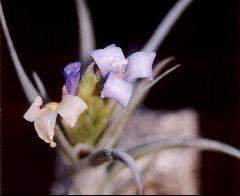
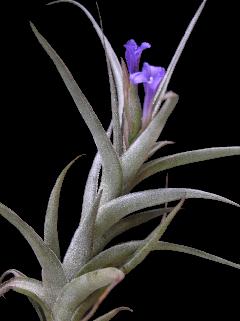
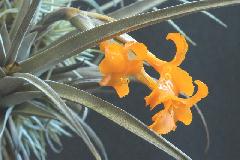
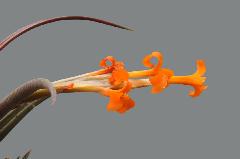
| T. gerdae Ken Woods 12/07 |
T. erici Eric Gouda. |
T. erici Chris Larson. From Lotte 1999, ex. Tarija, Bolivia. |
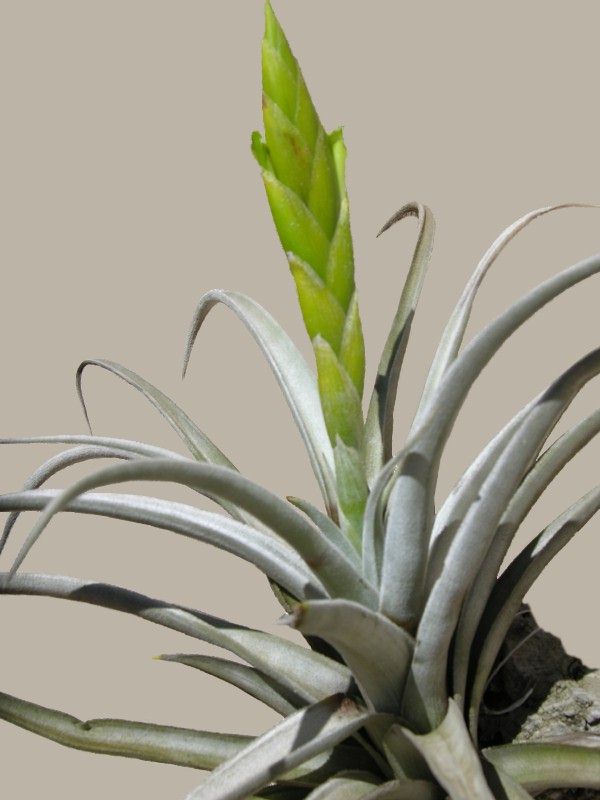
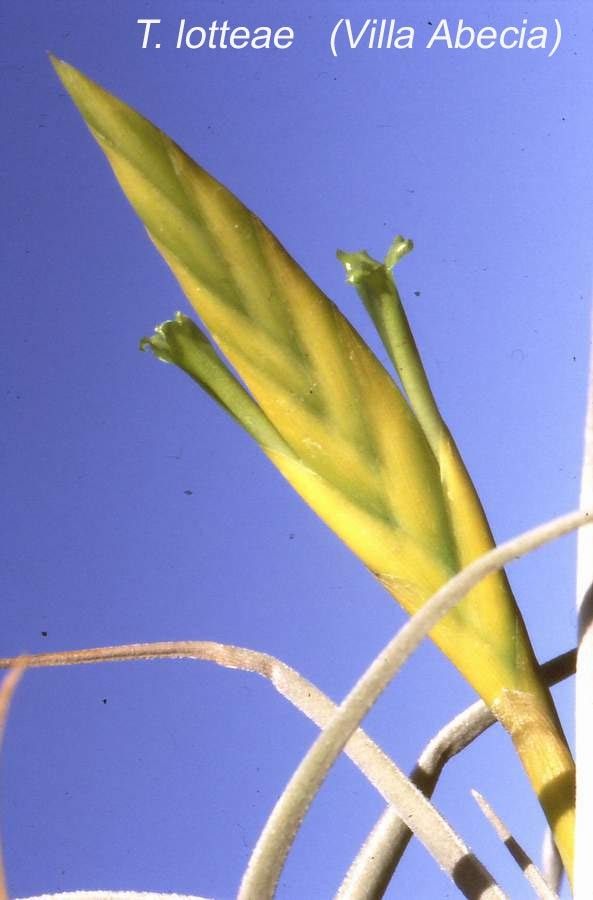
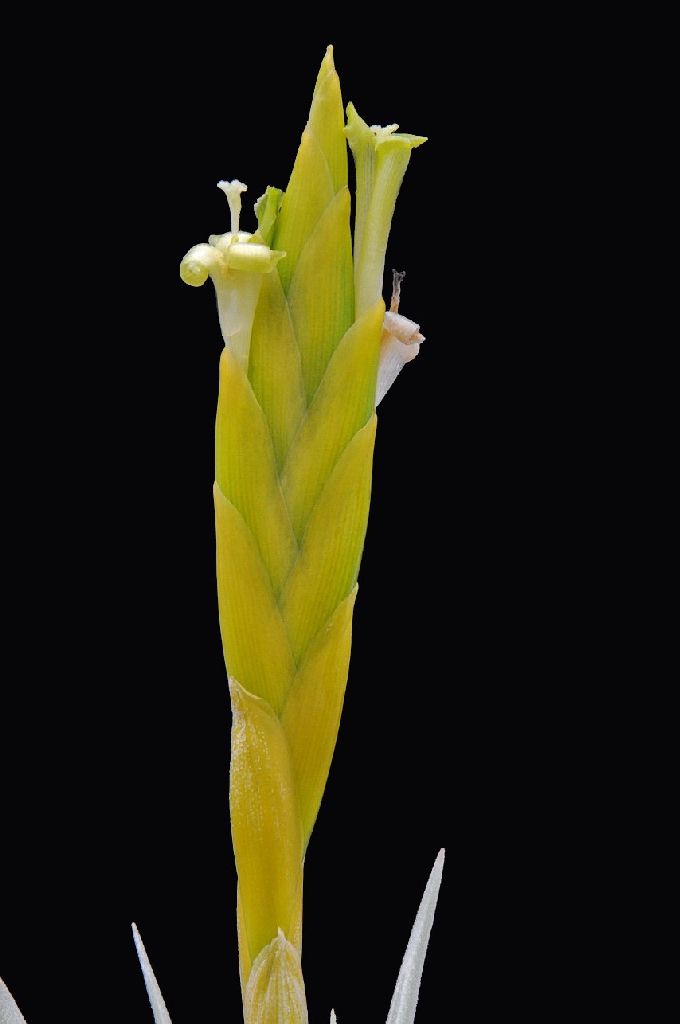
| T. lotteae Len Colgan 04/13. |
T. lotteae Peter Tristram 04/13. |
Len Colgan....."originally collected in 1993 just north of Villa Abecia in Bolivia, this form is BOL #26.
It was the most southerly habitat where I found T. lotteae, and was by far the largest form. Some of the plants at the location were more than 50cm high, but I restricted myself to two plants about 35cm high.
The first attached image is very old and of low resolution, but was taken around 1995 at my first flowering. The second image would be third generation since then, now in flower. This plant is somewhat smaller (30cm high) than its great-grandparent and has disappointingly smaller flowers.
I have different forms, from different locations, growing together. Over the years, seed has germinated on the shadecloth immediately behind these plants, which I have grown on, despite knowing that they are a very, very slow species, especially when I do not fertilise them at all. The largest seedlings are now 10cm across and 18 years old. There are lots of smaller ones, of course."
Peter Tristram..."I well remember the thrill of first seeing this species pictured in the BSI journal when it was described but it was a while before I finally obtained some.
Len has had the privilege of seeing these magnificent Tillandsias in habitat, something most of us can only dream of. I have a few of Len's seedlings too, now about 3cm or so."
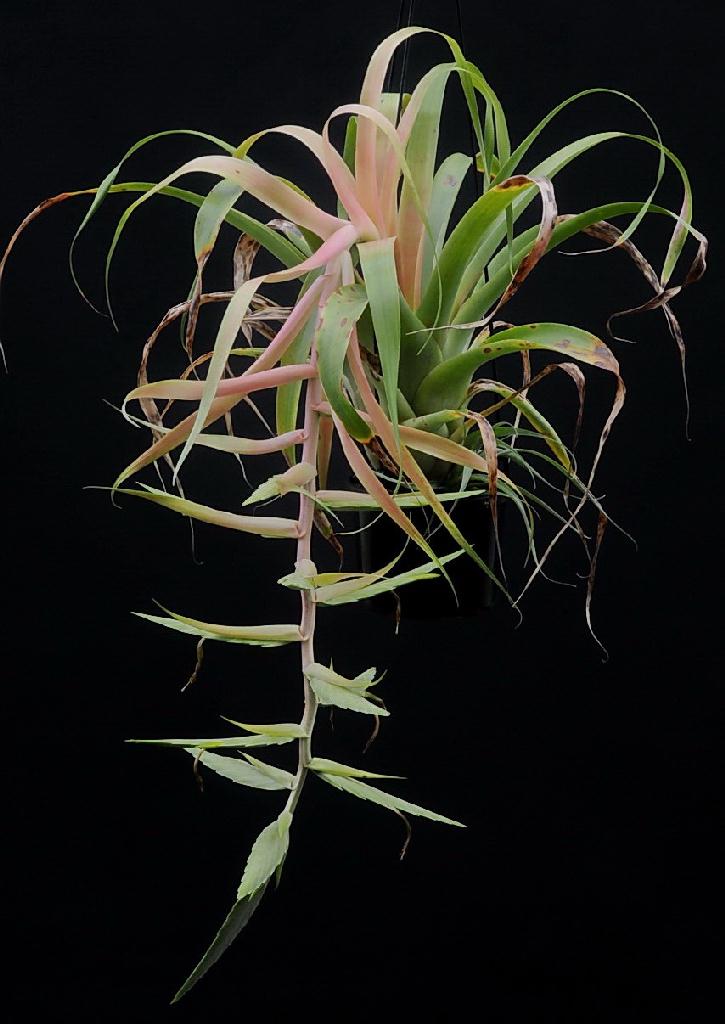
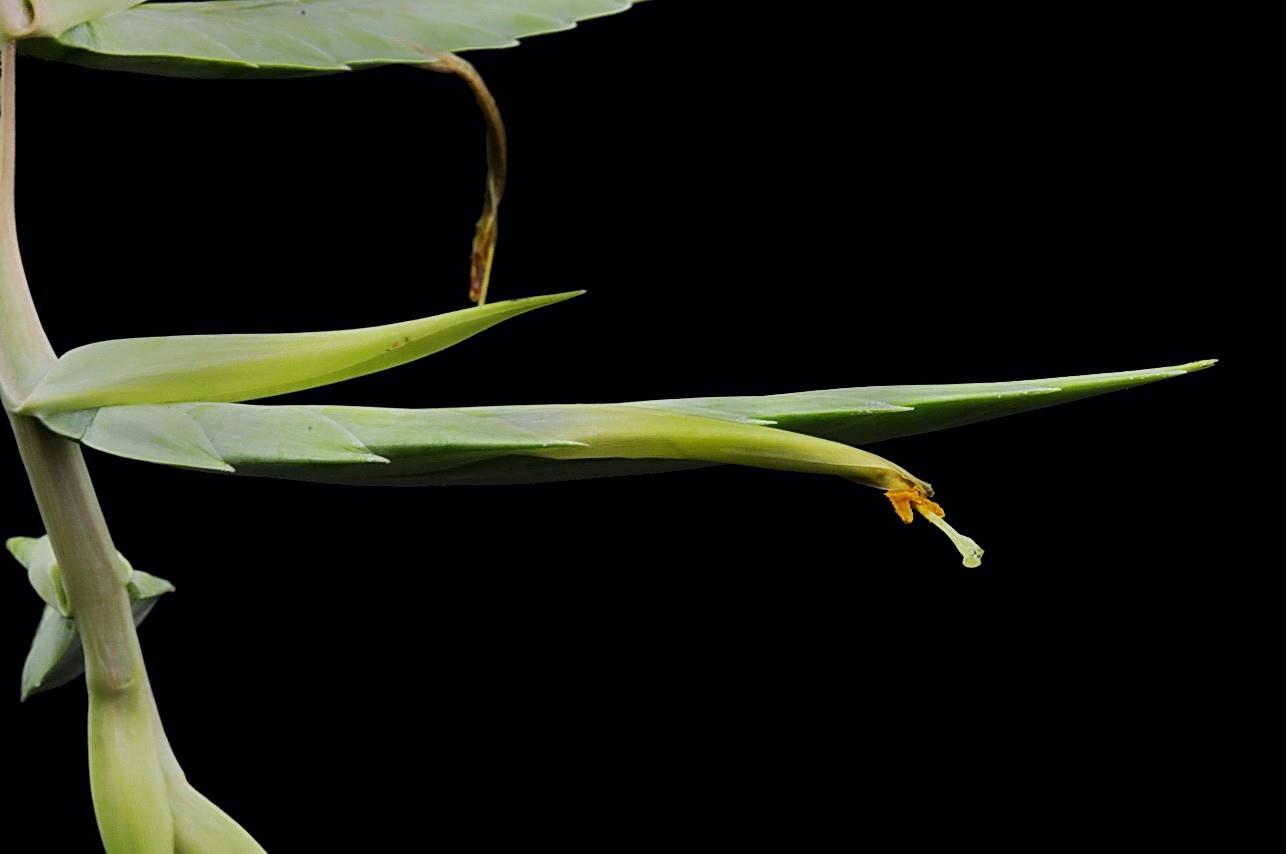
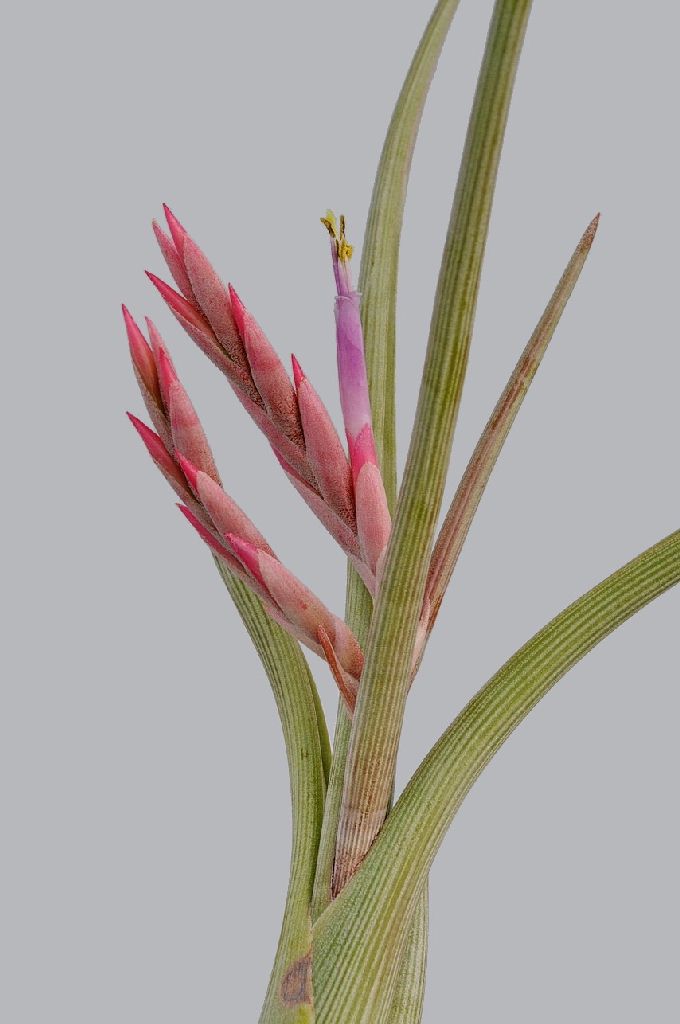
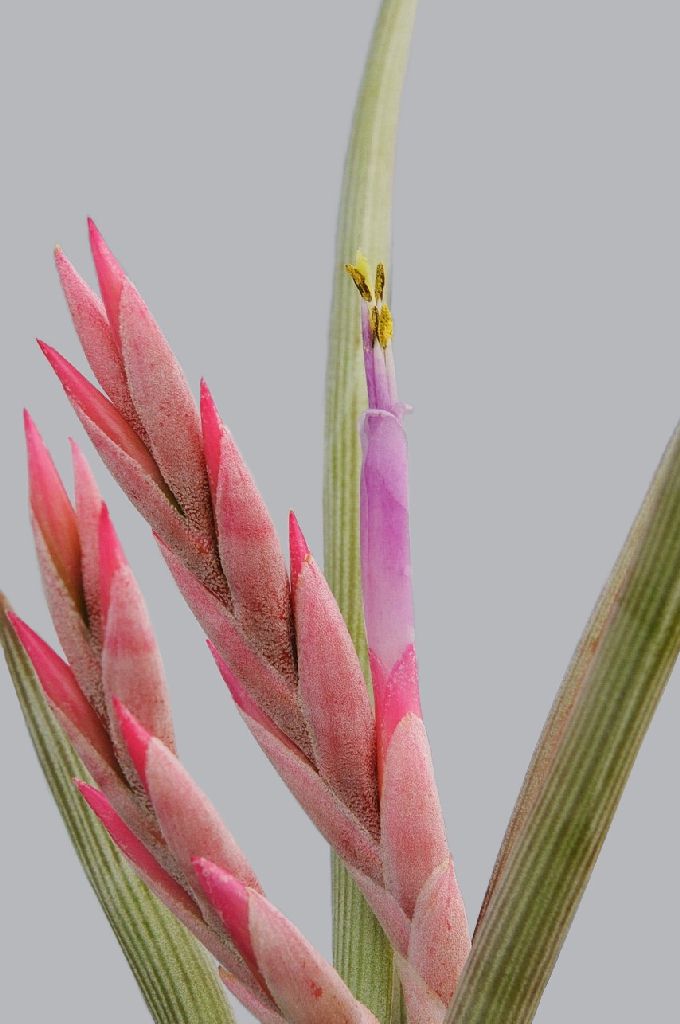
| T. hromadnikiana Peter Tristram 12/11. |
T. lydiae Peter Tristram 02/13. |
| get pics of T. helmutii & T. koehresiana & some plants/details from the Fosters! |
George Stamatis 15/02/13
This discussion would make a great BSI article if accompanied by photos of the species mentioned.
Peter Tristram 15/02/13 10:16am
Yes, my thoughts too George, and also add in Die Bromelie and many Aussie journals at least. We are always after material for the journals, no matter what the circulation. I canvass mainly for Die Bromelie and the BSI journal as I am involved with the editorial process in both. The first issue of the German Journal will be out soon - renewals are also due (you should get a renewal reminder in it). The BSI journal is up to the special Harry Luther edition (2012-6). 2012-5 is at the printers and features articles by 3 Aussies including 86 year old Bill Morris*.
It’s interesting, as Len points out, that the spouse teams are all Europeans these days. Even Eric and Renate Gouda go in the field together now!
I agree that both of Lydia’s namesakes are tricky to grow but they make it through the adverse seasons for each and occasionally bloom.
(*See N. Bill Morris for details.)
| Any pics of names involving Harry Luther ??? |
Len Colgan 15/02/13 1:32pm
If I recall correctly, John O. also managed to flower T. lydiae. Out of curiosity, John, did you get viable offsets?
T. koehresiana comes from the same area of Bolivia as the various forms of T. gerdae. The latter species is easy to grow and flowers regularly, and I
also have oodles of seedlings. Why then did each of my T. koehresiana die in Adelaide without even putting up a fight?
Derek Butcher 15/02/13 12:13pm
Big Len has started me off on suffixes or the ends of words -especially Latin ones.
Firstly Eric Gouda and myself have been arguing about this. You will have seen my list of names and synonyms. This is a conglomeration of lists from Harry's binomials, Smith and Downs, Mez 1935 and Baker 1889 where each has their own thoughts on what endings to use. Eric has a list too which is based on the protologues and original namings, THEY just do not match. Add to this the use or non-use of hyphens and you have a dog's breakfast. Eventually Eric's list will replace mine - in a few years time!
Now to Len's problem, and yes it is a problem.
We all know about Puya butcheriana (I hope). It was not called Puya butcherii because I did not find the plant but stirred up interest in this taxon.
Luckily it was not a Cryptanthus, otherwise it would have been called butcherianus !
We all know about T. colganii because a bloke called Colgan found the plant. It was not called colganiae because Len is not a she!
Talking about ae we know the Yanks want T. edithiae but the Germans want T. edithae.
CONFUSED! Eric and I have agreed to play down the significance of suffixes. They seem to change like changing your underwear. We think that names should stay as they were at the beginning. Botanists and others should heed the plea of Greuter et al. and only change things if absolutely necessary.
Finally, if you want to commemorate TWO or more people you use the suffix of orum. Thus if Rauh was doing his job properly he would have used T. ehlersorum.
For Vriesea lovers you may recall Vriesea bleheri which Harry insisted was bleherae even though it was named after both Amanda and Michael and should have been bleherorum.
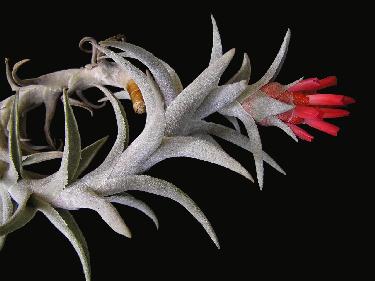
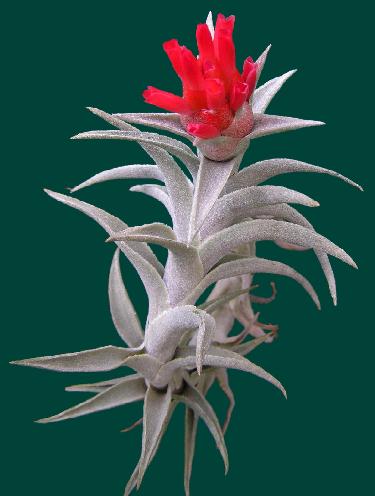
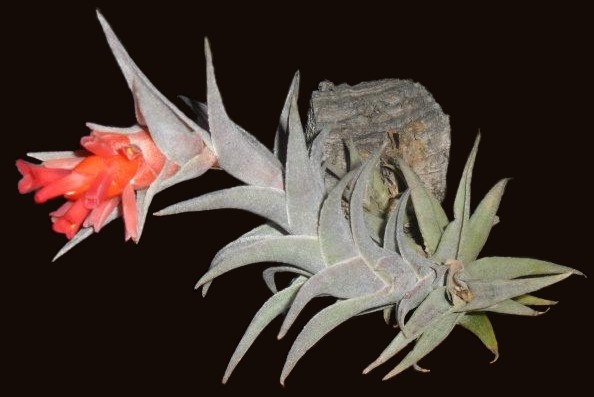
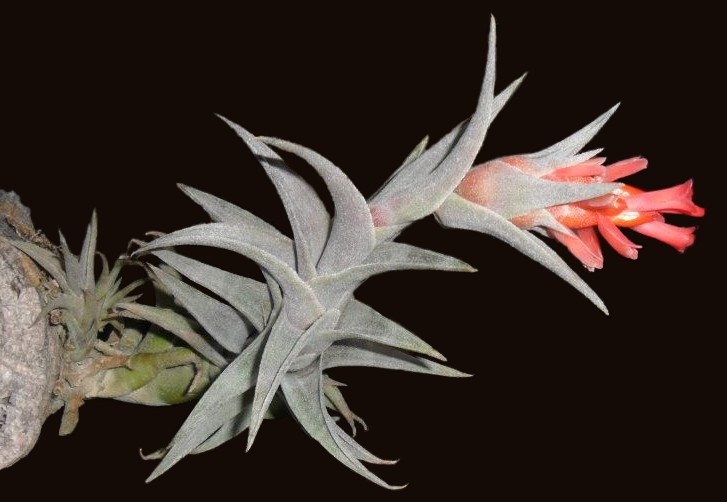
| T. edithae Ken Woods 02/11. |
T. edithae BSA meeting Comp. 12/11. Photo Sharon Song. |
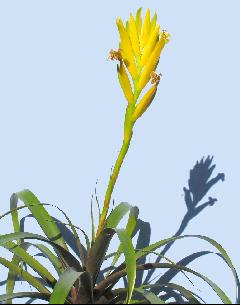
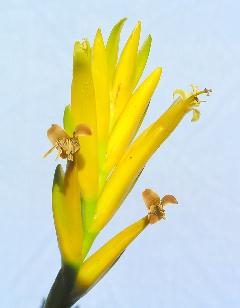
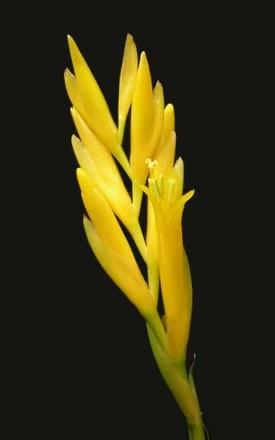
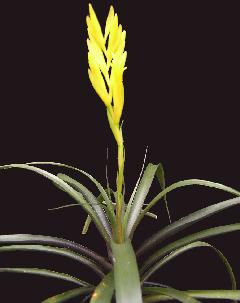
| Vr. bleherae Derek Butcher. |
Vr. bleherae Ken Woods. |
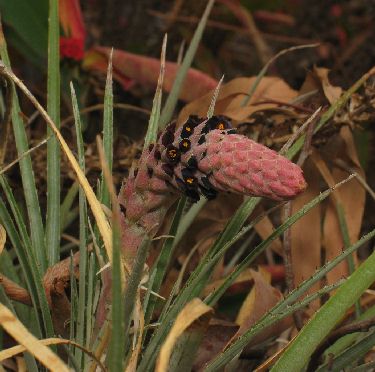
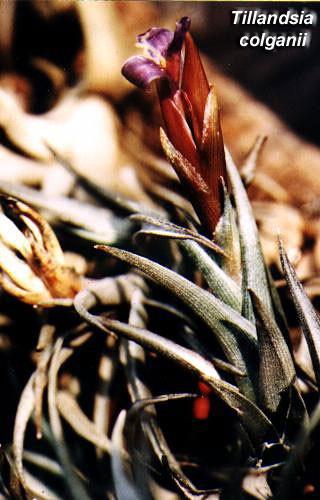
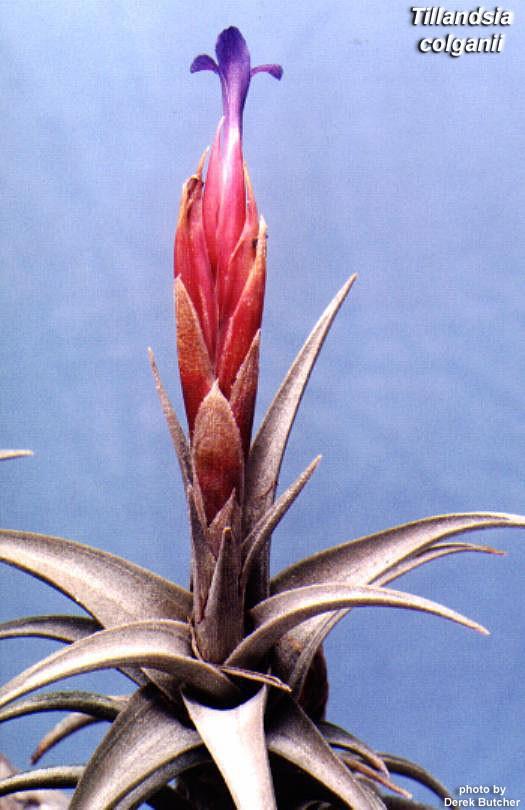
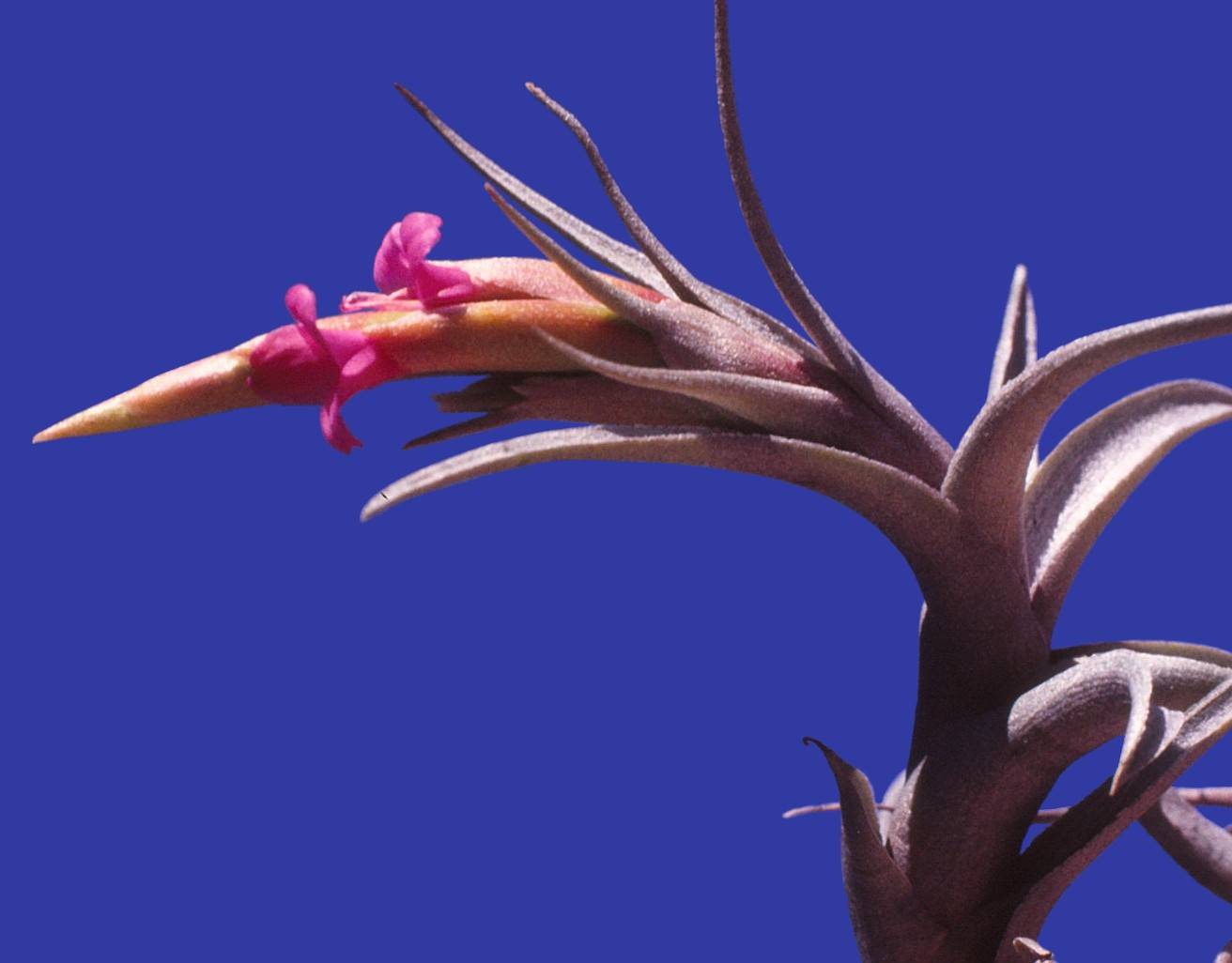
P. butcheriana Photo by Benetay, Singapore. Now reduced to synonymy with P. humilis.
See P.humilis |
T. colganii, photos D.Butcher. Named after Len Colgan. See below for full story. |
T. rubia, photo Len Colgan. |
Peter Tristram 15/02/13 3:00pm
Regarding T. koehresiana, I don't remember a flower appearing but I'm sure an aborted blooming happened a while back. Most I have imported have died in Q
or just after. I get one or 2 sluggish offsets from T. lydiae when it occasionally blooms. I think it likes to be always warm and humid - certainly hates winter here even though it is heated to 9C where I keep it.
Two more Europeans to add to the matrimonial teams. I have no doubt there are more still. Luckily none have divorced! How many defacto teams too? As for the endings and hyphens, I gave up making sense years ago. Even spellings can be an issue esp. if named after a place where there can be multiple spellings though these tend to get sorted out. Funny how an old language with a plethora of esoteric endings was chosen by the taxonomic pioneers. Was this about exclusivity? No wonder plenty of mistakes are made, even after peer review!
There's still time for butcherianus.
Tillandsia colganii R. Ehlers, J.Brom. Soc. 47:103-6. 1997
Plant saxicolous, pulvinate, often branched, with stout, branched, light brown roots, flowering 10-15 cm high.
Stem longer than the rosette, short to 13 cm long caulescent, to 7 cm in diameter, sometimes slightly secund.
Leaves 12-14 in number, polystichous, 3-7 cm long, the lower ones reduced and with short acuminate blades, the sheaths erect or suberect, the blades spreading or recurved, coriaceous-subsucculent, with asymmetric keel, green-grey, covered with appressed cinereous scales, looking grey, abaxially strongly nerved and looking striped, the margins with asymmetric trichomes.
Sheaths 2-3 cm long, 1-1.8 cm wide, ovate, merging imperceptibly into the blades.
Blades 1-1.5 cm wide at base, triangular, attenuate, subulate, channeled.
Scape erect, short and stout, from practically none to 1-2 cm long, nearly hidden in the rosette, imbricately concealed by few scape bracts, the lower ones foliaceous, lepidote and attenuate, the apical ones like the floral bracts, acute, red, becoming more and more glabrous.
Inflorescence terminal, simple, exceeding the rosette, 3-4 cm long, 5-8 (-10) mm wide, lanceolate acute, subterete, composed of few (2-3) distichous, sessile odorless flowers plus 1 sterile bract at the base, rhachis nearly straight, 4-angled, green, glabrous.
Floral bracts imbricate, the rhachis at anthesis not exposed, 1.6-2.5 (-2.8) cm long, exceeding the sepals, 8-10 mm wide, ovate-triangular, acute or cuspidate, submembranaceous, ecarinate, adaxially nerved, abaxially sublustrous wine-red, glabrous, the apical 4-6 mm finely grey lepidote.
Sepals 1.4-1.6 cm long, 4.5-6 mm wide, narrowly elliptic, acute, free, membranaceous, the posterior ones carinate, thickened along the keels, greenish with pink tips.
Petals 3.6-4 cm long, the blade 5 mm wide, obtuse, the margins entire not serrate, claw 3 mm wide at base, forming an erect tube with open throat, their tips spreading to strongly revolute, aster-violet, white at base.
Stamens barely included and visible, as long as the pistil, stigma 2-12 mm exserted from the throat of the corolla. Filaments 2.5-3 cm long, 0.8 mm wide, flat, thin towards the base, straight or once transversely plicate, anthers 4-5 mm long, 0.5 mm wide, linear, acute, basifixed, yellow. Pollen lime-yellow. Style 2.5-3 cm long, 1 mm wide at base and white, 0.7 mm wide at apex and yellowish, surpassing the stamens, stigma 4 mm long, 3 mm wide, lobes spreading, narrow, papillose, yellowish.
Ovary 4 mm long, 2.5 mm wide at base, ovate, light green.
Type. Bolivia. Dept. of Santa Cruz, Prov. Mendez: Paichu-Canon, between Cana Cruz and Coral Grande. July-August 1993: Len Colgan #23; (Heger #51), Coral Grande - Cana Cruz, 2700-3000 m s.m. Feb. 5 and 6; 1995 Paichu-Canon, 3000 - 3200 m s m. Ehlers EB 951002, and 2700-2900 m s m. Ehlers 951101, (holotype and paratype, WU)
Distribution: Bolivia. Dept. of Santa Cruz, Prov. Mendez: Paichu-Canon, 2700-3200 m. The plant is currently known only from the type location. It was collected for the first time in July, 1993 by Len Colgan from Australia, Ewald Heger, Wolfgang Krahn, and Helmut Alber from Germany. It was re-collected in March, 1995 by Frank Hase, Ewald Heger, Lotte Hromadnik and Renate Ehlers.
The plants grow in large clumps on the rock walls of the Paichu Canyon accompanied by Tillandsia aff. lorentziana, T. sphaerocephala, Blossfeldia sp?, and Puya sp?
Tillandsia colganii appears to be related to T. friesii Mez and T. hegeri R. Ehlers, but differs by the following characters:
From T. friesii Mez:
Stem shorter,
Inflorescence subterete, distichously arranged
Floral bracts stronger nerved and lepidote at apex,
Sepals longer,
Petals violet not red.
From T. hegeri R. Ehlers:
Plant caulescent, the rosette narrower, only to 7 cm in diameter,
Leaves shorter and more stout,
Inflorescence narrower (at most, half as wide), less complanate, subterete, composed of fewer flowers,
Floral bracts smaller and much narrower, (8-10 not 14-16 mm wide ), lepidote towards the apex, ecarinate,
Sepals shorter and only half as wide,
Petals narrower, the margins entire not serrate, the tips revolute and sometimes twisted,
Stigma exposed.
Tillandsia colganii is dedicated to its discoverer Len Colgan, from Adelaide, South Australia, who discovered the plant during a trip to Bolivia in July, 1993. Mr. Colgan is the President of the South Australian Bromeliad Society and an avid bromeliad grower who, through many years of contact and cooperation, has become a good friend.
The Discovery of Tillandsia colganii by Len Colgan
In July and August 1993, I was honored to be invited to join three imminent German cactus enthusiasts on a five-week camping and discovery trip covering an extensive area in Bolivia. I clearly understood that this was primarily a cactus¬oriented expedition to study species in habitat. Nevertheless, the other members were extremely considerate and I was able to gather tillandsias from fifty locations during the trip. It is relevant to know that Ewald Heger, Helmut Alber, and Wolfgang Krahn not only have a number of cactus species named after them, they have also discovered individually some Tillandsia species, including T. hegeri, T. alberi, and T. krahnii.
We travelled through the Andes at altitudes varying from a snow-covered 4700 m ranging down to a temperate 1500 m. However, most of the time was spent in the mid range around 3,000 m. The main hindrances were the bad roads and tracks, and the suffocating dust. It soon became obvious that cactus devotees have searched Bolivia thoroughly, but there are still many new opportunities for Tillandsia enthusiasts. Just after the trip's midpoint, we arrived back in Iscayachi, in southern Bolivia. Our detailed map showed a trail heading due north, but we could not find an access, as we were blocked by either deep trenches or a wide river. After multiple versions of advice from numerous sources, we eventually found a ford to cross. Surprisingly, the road was not nearly as bad as it had been for most of the rest of our trip in Bolivia. The first excitement came when the German collectors thought they might have found a new cactus variety, as well as some rare Blossfeldia species. Photographs were taken and details recorded.
This increased the likelihood that new Tillandsia discoveries might lie ahead even though the only bromeliads seen were Puya and Deuterocohnia species. Eventually we inched down a steep section, getting covered in layers of dust in the process, after which we were able to find and collect clumps of a fascinating Tillandsia growing on rocks. The plants were covered with a dense white layer of trichomes, giving it a distinct appearance. They keyed out to be somewhere between T. lorentziana and T. zecheri, having a single spike with red bracts and blue flowers. Further on we found another group of tillandsias. At first glance I knew this was something new. The only other species that seemed similar was T. hegeri, which we had collected some weeks earlier, but with which there were significant differences. To proceed further we had to drive in a river bed up the Peichu Canyon, where we discovered more plants of the same two species. This location was more moist than the previous ones. Beyond that, I recall one photograph of six different attractive Cactus species growing together. We experienced several more tire punctures, due mainly to the dangerous branches of thorn bushes hidden under layers of dust. When we eventually returned to Iscayachi, there was no doubt that this two day detour had been rewarding for all of us. The second of these two tillandsias found that day is now named T. colganii, and I thank Renate Ehlers for that honor. She went to the same location in early 1995, in a group also led by Ewald Heger, and collected the same species that she has since described and generously named after me.
Adelaide, South Australia
Some hybridists add a prefix name to cultivars/hybrids they register.
1. It is unlikely that name has already been used.
2. It keeps them all together on the Cultivar Register.
3. Sometimes this is also done when more than one plant from a grex is registered.
4. Their preferred name may have already been taken, so a prefix of owner or breeder is added.
Some examples...
Kolan = Russ Holzheimer (QLD)
Gympie = Margaret Paterson (QLD)
Tara = Diana Holt (NZ)
Totara - Peter Coyle (NZ)
Rangeview = Peter Kilpatrick (QLD)
Bonville/Moet = Jan & Jon Townsend (NSW)
Koah = Ross Draper (QLD)
Kingfisher = Neil Bain (QLD, RIP)
Mai = Andrew Devonshire (NZ)
Somerset = Robert Marks (QLD)
Anniesame = Tamera Ison (NSW)
Downs = Ivan Hole (QLD, RIP)
Talbot = Len & Sheryl Waite (QLD)
Coolum = (Cheryl & Ema Basic (QLD) {& Stan Walkely (QLD)?}
Coonarr = Val Honeywood (QLD)
Valley = Aaron Smythe (QLD)
Fallen Trees = Julie Nichols (QLD)
Plateau = Graeme McDonald (NSW)
Kawana = Stuart Beasley (QLD) (But I hear that Stuart is not keen on this being used.)
Etty Bay, I love Etty Bay = Rob & Marie Giddins
Canvey = Olive, Len, Beck Trevor at The Olive Branch (QLD)
Maroochy = Alan Phythian (QLD)
Hunua = John Mitchell (NZ)
Pinegrove - Ross Little
Somerset - Robert Marks (doesn't use Blackbutt as prefix)
Updated 07/11/23





























